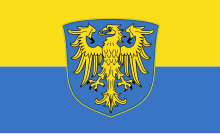 Global Information
Global InformationSilesians information
| |
|---|---|
 Flag of Upper Silesia | |
| Total population | |
| Several million (of which about 0.8 million officially declared Silesian nationality in national censuses in Poland, the Czech Republic and Slovakia). | |
| Regions with significant populations | |
| c. 2.4–3.6 million[1] | |
| 585,786[2] officially declared Silesian nationality. (Polish-Silesian nationality included) | |
| No data, 31,301 declared Silesian nationality, of which 12,451 declared it as their only nationality[3] | |
| no data; 22 declared Silesian nationality[4] | |
| Languages | |
| Silesian Polish German (incl. Silesian German dialects) Czech (Cieszyn Silesian and Lach dialects) | |
| Religion | |
| Roman Catholicism Protestantism (Mainly Lutheranism) | |
| Related ethnic groups | |
| Other West Slavs, other Germans, Vilamovians | |




Silesians (Silesian: Ślōnzŏki or Ślůnzoki; Silesian German: Schläsinger or Schläsier; German: Schlesier pronounced [ˈʃleːzi̯ɐ] ⓘ; Polish: Ślązacy; Czech: Slezané) is a geographical term[5] for the inhabitants of Silesia, a historical region in Central Europe divided by the current national boundaries of Poland, Germany, and the Czech Republic. Historically, the region of Silesia (Lower and Upper) has been inhabited by Polish (West Slavic Lechitic people), Czechs, and by Germans.[6] Therefore, the term Silesian can refer to anyone of these ethnic groups. However, in 1945, great demographic changes occurred in the region as a result of the Potsdam Agreement leaving most of the region ethnically Polish and/or Slavic Upper Silesian. The Silesian dialect is one of the main dialects of the Polish language and based on Polish/Lechitic grammar. The names of Silesia in different languages most likely share their etymology—Polish: ⓘ; German: Schlesien pronounced [ˈʃleːzi̯ən] ⓘ; Czech: Slezsko [ˈslɛsko]; Lower Silesian: Schläsing; Silesian: Ślōnsk [ɕlonsk]; Lower Sorbian: Šlazyńska [ˈʃlazɨnʲska]; Upper Sorbian: Šleska [ˈʃlɛska]; Latin, Spanish and English: Silesia; French: Silésie; Dutch: Silezië; Italian: Slesia; Slovak: Sliezsko; Kashubian: Sląsk. The names all relate to the name of a river (now Ślęza) and mountain (Mount Ślęża) in mid-southern Silesia, which served as a place of cult for pagans before Christianization.
Ślęża is listed as one of the numerous Pre-Indo-European topographic names in the region (see old European hydronymy).[7] According to some Polonists, the name Ślęża [ˈɕlɛ̃ʐa] or Ślęż [ɕlɛ̃ʂ] is directly related to the Old Polish words ślęg [ɕlɛŋk] or śląg [ɕlɔŋk], which means dampness, moisture, or humidity.[8] They disagree with the hypothesis of an origin for the name Śląsk [ɕlɔ̃sk] from the name of the Silings tribe, an etymology preferred by some German authors.[9]
The term "Silesia" is a Latinized word of the original Polish/Lechitic name "Śląsk" inhabited by the ancient Lechitic tribes called Ślężanie. In Silesia, there are many places of the ancient Slavic Lechitic pagan cult of these ancient people, for example Góra Ślęża.
847,000 people declared themselves to be of Polish nationality from the Silesian region in the 2011 Polish national census (including 376,000 who declared it to be their only description and 431,000 who declared joint Silesian and Polish nationality. (legally there is no Silesian nationality. That is, about 10% of the population of the Polish part of Upper Silesia declares themselves as only Silesians),[2] making them the largest minority group. About 126,000 people declared themselves as members of the German minority (58,000 declared it jointly with Polish nationality), making it the third largest minority group in the country (93% of Germans living in Poland are in the Polish part of Silesia). 31,301 people declared Silesian nationality in the Czech national census of 2021, including 18,850 of those who declared two nationalities[3] (44,446 in Czechoslovakia in 1991),[10] and 6,361 people declared joint Silesian and Moravian nationality in the Slovak national census.[11] Over 85% of the population in the Polish part of Upper Silesia declare themselves as Poles, and in the Czech part as Czechs.
During the German occupation of Poland, Nazi authorities conducted a census in East Upper Silesia in 1940. At the time, 157,057 people declared Silesian nationality (Slonzaken Volk), and the Silesian language was declared by 288,445 people. However, the Silesian nationality could only be declared in the Cieszyn part of the region. Approximately 400–500,000 respondents from the other areas of East Upper Silesia who declared "Upper Silesian nationality" (Oberschlesier) were assigned to the German nationality category.[12] After World War II in Poland, the 1945 census showed a sizable group of people in Upper Silesia who declared Silesian nationality. According to police reports, 22% of people in Zabrze considered themselves to be Silesians, and that number was around 50% in Strzelce County.[13]
- ^ "Volkszählung vom 27. Mai 1970" Germany (West). Statistisches Bundesamt. Kohlhammer Verlag, 1972, OCLC Number: 760396
- ^ a b Przynależność narodowo-etniczna ludności – wyniki spisu ludności i mieszkań 2021. Retrieved 2021-04-11.
- ^ a b "Národnost". Census 2021 (in Czech). Czech Statistical Office. Retrieved 8 December 2022.
- ^ "Bilancia podľa národnosti a pohlavia - SR-oblasť-kraj-okres, m-v [om7002rr]" (in Slovak). Statistics of Slovakia. Retrieved 31 July 2019.
- ^ Dillingham, William Paul; Folkmar, Daniel; Folkmar, Elnora (1911). Dictionary of Races or Peoples. Washington, D.C.: Washington, Government Printing Office. p. 128.
- ^ Kunce, Aleksandra (2019). Being at Home in a Place: The Philosophy of Localness (PDF). Elipsa. pp. 41–112. ISBN 978-83-8017-270-8.
- ^ Zbigniew Babik, "Najstarsza warstwa nazewnicza na ziemiach polskich w granicach średniowiecznej Słowiańszczyzny", Uniwersitas, Kraków, 2001.
- ^ Rudolf Fischer. Onomastica slavogermanica. Uniwersytet Wrocławski. 2007. t. XXVI. 2007. str. 83
- ^ Jankuhn, Herbert; Beck, Heinrich; et al., eds. (2006). "Wandalen". Reallexikon der Germanischen Altertumskunde (in German). Vol. 33 (2nd ed.). Berlin, Germany; New York City: de Gruyter.
Da die Silingen offensichtlich ihren Namen im mittelalterlichen pagus silensis und dem mons slenz – möglicherweise mit dem Zobten gleichzusetzen [...] – hinterließen und damit einer ganzen Landschaft – Schlesien – den Namen gaben [...]
The name in Silesian dialect:'Ślōnzŏki, Ślůnzoki (Silesian) in Polish language Ślązacy (Polish), Old Polish Ślężnie, colloquial Polish Ślązaki, Ślązoki
Slezané (Czech) - ^ "Národnost ve sčítání lidu v českých zemích" (PDF). Archived from the original (PDF) on 2009-10-07. Retrieved 2012-08-16.
- ^ "Archived copy". www.greekhelsinki.gr. Archived from the original on 6 April 2003. Retrieved 15 January 2022.
{{cite web}}: CS1 maint: archived copy as title (link) - ^ "Górny Śląsk: szczególny przypadek kulturowy" (en: "Upper Silesia: special case of cultural") - Mirosława Błaszczak-Wacławik, Wojciech Błasiak, Tomasz Nawrocki, University of Warsaw 1990, p. 63
- ^ "Polityka antyniemiecka na Górnym Śląsku w latach 1945-1950" - Bernard Linek, Opole 2000, ISBN 978-83-7126-142-8